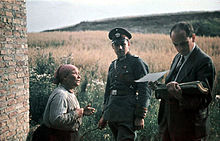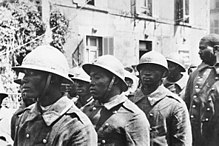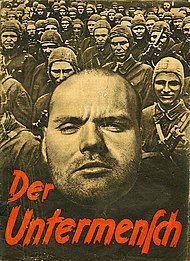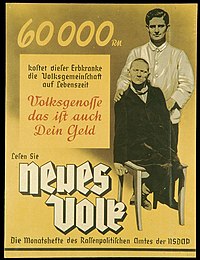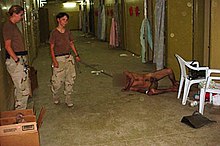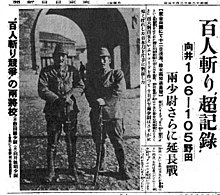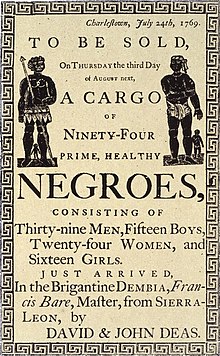The Nazi Party adopted and developed several hypotheses concerning their concept of race. Classifications of human races were made and various measurements of population samples were carried out during the 1930s and '40s.
Racial hierarchy
The Nazis claimed to observe a strict scientific hierarchy of the human race. Hitler's view towards race and people can be found throughout Mein Kampf but more specifically in chapter 11 "Nation and Race". The standard-issue propaganda text issued to members of the Hitler Youth contained a chapter on "the race of the German people" that heavily cited the works of Hans F. K. Günther. The text seems to address the European races in descending orders on the Nazi hierarchy, with the Nordic race (plus the subrace of Phalic) first, the Western (Mediterranean) race second, Dinarics third, Eastern (Alpine) people fourth, and finally East Baltics last.
Aryan: Nordic and Germanic
Hitler made references to an "Aryan race" founding a superior type of humanity. The purest stock of Aryans according to Nazi ideology was the Nordic people of Germany, England, the Netherlands and Scandinavia. The Nazis defined Nordics as being identified by tall stature (average 175 cm), long faces, prominent chins, narrow and straight noses with a low bridge, lean builds, doliocephalic skulls, straight light hair, light eyes, and fair skin. The Nazis claimed that Germanic people specifically represented a southern branch of the Aryan-Nordic population. The Nazis did not consider all Germans to be of the Nordic type (which predominated the north), and stated that Germany also had a large "Alpine" population (identified by, among other features, lower stature, stocky builds, flatter noses, and higher incidences of darker hair and eyes). Hitler and Nazi racial theorist Hans F. K. Günther framed this as an issue to be corrected through selective breeding for "Nordic" traits. Hitler Youth propaganda emphasized the "Nordic" nature of Germans, with the text issued to all Hitler Youth members stating: "the principal ingredient of our people is the Nordic race (55%). That is not to say that half our people are pure Nordics. All of the aforementioned races appear in mixtures in all parts of our fatherland. The circumstance, however, that the great part of our people is of Nordic descent justifies us taking a Nordic standpoint when evaluating our character and spirit, bodily structure, and physical beauty."
East Asian races equal to Aryans or declared "Honorary Aryan"
The Han Chinese and Japanese races were both considered the "Aryans of the East", "Honorary Aryans" and the "Herrenvolk of the Orient" (i.e. the "Master race" of the Orient) by Nazi Germany.
In 1945, Adolf Hitler said:
German racial anthropologist Bruno Beger measuring a Tibetan woman's skull in the 1930sPride in one's own race, and that does not imply contempt for other races, is also a normal and healthy sentiment. I have never regarded the Chinese or the Japanese as being inferior to ourselves. They belong to ancient civilizations, and I admit freely that their past history is superior to our own. They have the right to be proud of their past, just as we have the right to be proud of the civilization to which we belong. Indeed, I believe the more steadfast the Chinese and the Japanese remain in their pride of race, the easier I shall find it to get on with them.
Adolf Hitler had allowed Han Chinese soldiers to study in German military academies and serve in the Nazi German Wehrmacht as part of their combat training. Since 1926, Germany had supported the Republic of China militarily and industrially. Germany had also sent advisers such as Alexander von Falkenhausen and Hans von Seeckt to assist the Chinese, most notably in the Chinese Civil War and China's anti-communist campaigns. Max Bauer was sent to China and served as one of Chiang Kai-shek's advisers. Around this time, Hsiang-hsi Kung (H. H. Kung), the Republic of China Minister of Finance, visited Nazi Germany and was warmly welcomed by Adolf Hitler on June 13, 1937. During this meeting, Adolf Hitler, Hermann Göring and Hjalmar Schacht bestowed upon Hsiang-hsi Kung an honorary doctorate degree, and attempted to open China's market to German exports. And in order to attract more Han Chinese students to study in Germany, Adolf Hitler, Hermann Göring and Hjalmar Schacht earmarked for 100,000 reichsmarks for Han Chinese students studying in the universities and military academies of Nazi Germany after they persuaded a German industrialist to set aside the money for that purpose. Additionally, Hsiang-hsi Kung, in favor of commercial credits, politely refused a generous international loan offer by Adolf Hitler. The most famous of these Han Chinese Nazi soldiers was Chiang Wei-kuo, the son of Republic of China President Chiang Kai-shek, who studied military strategy and tactics at a Nazi German Kriegsschule in Munich, and subsequently achieved the rank of lieutenant and served as a soldier in the Wehrmacht on active combat duty in Europe until his return to the Republic of China during the later years of World War II.
Adolf Hitler had supported the Empire of Japan as early as 1904, when during the Russo-Japanese War it had defeated the Russians, which he considered a defeat for Austrian Slavism. He made a number of other statements expressing his respect and admiration for the Japanese in his book Mein Kampf.
Although they belonged to a different evolutionary race than the Germans did, the Han Chinese and the Imperial Japanese were both considered to have sufficiently superior qualities as were people with German-Nordic blood to warrant an alliance by Nazi ideologists such as Himmler. Himmler, who possessed a great interest in, and was influenced by, the anthropology, philosophies and pantheistic religions of East Asia, mentioned how his friend Hiroshi Ōshima, the Japanese Ambassador to Germany, believed that the noble castes in Japan, the Daimyō and the Samurai, were descended from gods of celestial origin, which was similar to Himmler's own belief that "the Nordic race did not evolve, but came directly down from heaven to settle on the Atlantic continent."
Karl Haushofer, a German general, geographer, and geopolitician, whose ideas may have influenced the development of Hitler's expansionist strategies, saw Japan as the brother nation of Germany. In 1908, he was sent to Tokyo by the German Army "to study the Japanese Army and advise it as an artillery instructor. The assignment changed the course of his life and marked the beginning of his love affair with the orient. During the next four years he traveled extensively in East Asia, adding Korean, Japanese, and Mandarin to his repertoire of Russian, French, and English languages. Karl Haushofer had been a devout student of Schopenhauer, and during his stay in the Far East he was introduced to Oriental esoteric teachings." It was based on such teachings that he came to make similar bestowals of his own upon the Japanese people, calling them the "Aryans of the East", and even calling them the "Herrenvolk of the Orient" (i.e. the "Master race of the Orient").
The Chinese and Japanese were still subject to Germany's racial laws, however, which – with the exception of the 1935 Nuremberg Laws, which specifically mentioned Jews – generally applied to all "non-Aryans" although since Japanese and Chinese were given "Honorary Aryan" status these racial laws were applied to them in a more lenient manner as compared to other "non-Aryans" who were not granted "Honorary Aryan" status by Adolf Hitler. Hitler's government began enacting the laws after taking power in 1933, and the Japanese government initially protested several racial incidents involving Japanese or Japanese-Germans that year which were then resolved by the Nazi high command by treating their Japanese allies leniently in these disputes. Especially after the collapse of Sino-German cooperation and Chinese declaration of war on Germany, Chinese nationals faced prosecution in Germany. Influential Nazi anti-Semite Johann von Leers favored excluding Japanese from the laws due both to the alleged Japanese-Aryan racial link and to improve diplomatic relations with Japan. The Foreign Ministry agreed with von Leers and sought several times between 1934 and 1937 to change the laws, but other government agencies, including the Racial Policy Office, opposed the change.
An October 1933 statement by Foreign Minister Konstantin von Neurath which falsely claimed in response to the Japanese protests that Japanese were exempt, however, was widely publicized and caused many in Germany, Japan, and elsewhere to believe that such an exemption existed. Instead of a broad exemption, an April 1935 decree stated that racial discrimination cases involving non-Aryans that might jeopardize German diplomatic relations—i.e., Japanese—would be dealt with individually. Decisions on such cases often took years, with those affected unable to obtain jobs or interracially marry, primarily because the German government preferred as much as possible to avoid giving exemptions. The German government often exempted more German-Japanese than it preferred in order to avoid a repeat of the 1933 controversies, and in 1934 it prohibited the German press from discussing the race laws when Japanese were involved.
Aryan: Finns
As Germany invaded the Soviet Union in June 1941, Finland participated in the invasion primarily to recover the territories it was forced to cede to the USSR after the Moscow Peace Treaty which ended the Winter War between the Finns and the Soviets. Military success quickly resulted in the Finnish occupation of Eastern Karelia. Because of their Finno-Ugric language, the Finns were initially classified by Nazi racial experts as a people unrelated to the other Nordic countries, in spite of a long history of political unity with Sweden. As a result, the Swedish-speaking minority of Finland was favored at first over Finnish speakers for recruitment into the Finnish Volunteer Battalion of the Waffen-SS because they were categorically considered part of the "Nordic race".
Owing to Finland's substantial military contribution on the northern flank of the Eastern Front of World War II, Hitler decreed in November 1942 that "from now on Finland and the Finnish people be treated and designated as a Nordic state and a Nordic people", which he considered one of the highest compliments that the Nazi government could bestow upon another country.
Aryan: Lower classes
Britain
According to Gunther, the purest Nordic regions were Scandinavia and northern Germany, particularly Norway and Sweden, specifying: "We may, perhaps, take the Swedish blood to be over 80 per cent Nordic, the Norwegian blood about 80 per cent." Britain and southern Germany by contrast were not considered entirely Nordic. Germany was said to be 55% Nordic, and the rest Alpine (particularly southern Germany), Dinaric, or East Baltic (particularly eastern Germany). On the British Isles, Gunther stated: "we may adopt the following racial proportions for these islands: Nordic blood, 60 percent; Mediterranean, 30 percent; Alpine, 10 percent." He added that "The Nordic strain in Germany seems to be rather more distributed over the whole people than in England, where it seems to belong far more to the upper classes." Hitler echoed this sentiment, referring to the English lower classes as "racially inferior."
France
Hitler viewed the French as close to the Germans racially, but not quite their peers. He said of their racial character: "France remains hostile to us. She contains, in addition to her Nordic blood, a blood that will always be foreign to us." Gunther echoed this sentiment, saying that the French were predominantly Alpine and Mediterranean rather than Nordic, but that a heavy Nordic strain was still present. He characterized the French as possessing the following racial proportions: Nordic, 25%; Alpine or Dinaric, 50%; Mediterranean, 25%. These types were said to be most prevalent in north, central, and southern France respectively.
Hitler planned to remove a large portion of the French population to make way for German settlement. The Zone interdite of eastern France was set aside and planned to be made part of the German Reich after the rest of France was fully subdued. The French residents of the zone, some 7 million people accounting for nearly 20% of the French population at the time, were to be deported, and the land then occupied by at least a million German settlers. The plan was either postponed or abandoned after Operation Barbarossa in favor of expediting the settlement of the east instead, and was never put into place owing to the German defeat in the Second World War.
Mediterranean Aryans
The Nazis regarded Southern Europeans such as central/southern Italians, Spaniards, Portuguese, southern French, Albanians and Greeks as sharing a similar origin with Germans due to ancient Indo-Aryan migrations, but being almost purely of a distinct so-called Mediterranean race. Despite classifying these populations as Aryans, and regarding them as superior in the arts compared to Nordics and Germans, the Nazis considered them to be less industrious than predominantly Nordic peoples like the Germans and English were, and in keeping with this view, the Nazis considered them to be marginally inferior to the Nordic race. In Nazi propaganda the "Mediterranean" race was described as brown-haired, brown-eyed, light skinned but slightly darker than their Northern European counterparts, and short (average 1.62 m (5 ft 4 in)), with dolichocephalic or mesocephalic skulls, and lean builds. People who fit this category were described as "lively, even loquacious" and "excitable, even passionate", but they were also described as being "prone to act more on feeling than on reason", and as a result, "this race has produced only a few outstanding men."
The question of the South Tyrol was largely and pragmatically dealt with by Hitler and Mussolini: this region of Austria's Tyrol, which was annexed by Italy after 1919, would not become a constituent district of Ostmark (present-day Austria). Ethnic Germans who lived in the South Tyrol were given the option of either migrating back to the German Reich or remaining in the South Tyrol where they would undergo forced Italianization.
Eastern Aryans: Iranians
Beginning in 1933, the Nazi leadership in Germany made efforts to increase their influence in Iran, and they financed and managed a racist journal, Iran-e Bastan, co-edited by a pro-Nazi Iranian, Sheikh Abdul-Rahman Seif. This and other chauvinistic publications in the 1930s were popular among Iranian elites; they "highlighted the past and the pre-Islamic glories of the Persian nation and blamed the supposedly 'savage Arabs and Turks' for the backwardness of Iran." In Iran:
The Nazis found a favorable climate amongst the Iranian elite to spread fascistic and racist propaganda. The Nazi propaganda machine advocated the (supposedly) common Aryan ancestry of "the two Nations." In order to further cultivate racist tendencies, in 1936 the Reich Cabinet issued a special decree exempting Iranians from the restrictions of the Nuremberg Racial Laws on the grounds that they were 'pure-blooded' Aryans ... In various pro-Nazi publications, lectures, speeches, and ceremonies, parallels were drawn among Reza Shah, Hitler, and Mussolini to emphasize the charismatic resemblance among these leaders."
Nazi ideology was most common among Persian officials, elites, and intellectuals, but "even some members of non-Persian groups were eager to identify themselves with the Nazis" and a supposed Aryan race. Hitler declared Iran to be an "Aryan state"; the changing of Persia's international name to Iran in 1935 was done by the Shah at the suggestion of the German ambassador to Iran as an act of "Aryan solidarity."
In 1936, the Nazi Office of Racial Politics, in response to a question from the German Foreign Ministry, classified non-Jewish Turks as Europeans, but "left unanswered the question of how to think about the obviously non-European Arabs, Persians, and Muslims." Later that year, ahead of the Summer Olympic Games in Berlin, the Nazis responded to questions from the Egyptians by saying that the Nuremberg racial laws did not apply to them, and after the Iranian ambassador to Berlin "assured German officials that 'there was no doubt that the Iranian, as an Aryan,' was 'racially kindred (artverwandt) with the Germans," the German Foreign Ministry "assured the Iranian Embassy in Berlin that the correct distinction between was not between "Aryans and non-Aryans" but rather between "persons of German and related blood on one hand and Jews as well as racially alien on the other."
Historian Jeffrey Herf writes:
As a result of the discussions of spring and summer 1936, Nazi officials had reassured Arab diplomats that Nazi ideology and policy were directed against the Jews, not non-Jewish Semites. Nazism viewed Arabs and Muslims as different but, in clear contrast to the racial hierarchy presented in Mein Kampf, not as racially inferior. But as it was best that races not mix, non-Jewish Germans should marry other non-Jewish Germans. These abstruse discussions of the meaning of blood and race in summer 1936 offered a legal and conceptual foundation for reconciling German racial ideology and legislation with close and ongoing work with non-Jewish Semites, that is, Arabs and Muslims, before and during World War II. As a consequence of the exchanges of spring and summer 1936 and the Egyptian and Iranian decisions to attend the summer Olympics, German officials learned that they could reconcile Nazi Germany's anti-Jewish policies with efforts to find allies among non-Jewish Semites. They also learned that at least some Arab and Persian diplomats had no principled opposition to anti-Semitism so long as it was only aimed at Jews and even had become accustomed to thinking about peoples and nations in the racist categories emerging from the National Socialist regime.
Subhumans: Romani, Slavs and Jews
The Nazis thought that Eastern Europe, namely the areas whose inhabitants speak Slavic languages, was racially the lowest part of Europe, and very distinct from the rest of Europe. Hans Günther stated: "The east of Europe shows a gradual transition of the racial mixtures of Central Europe into predominantly East Baltic and Inner Asiatic regions... Owing to the likeness between East Baltic and Inner Asiatic bodily characters it will often be hard to fix a sharp boundary between these two races." Russia was thought to be 25% Nordic, while other regions were considered less Nordic.
Jews, Roma and Slavs (including Poles, Serbs and Russians) were not considered Aryans by Nazi Germany. Instead, they were considered subhuman and inferior races. A definition of Aryan that included all non-Jewish Europeans was deemed unacceptable by Nazis, and Expert Advisor for Population and Racial Policy included a definition defining Aryan as someone who is "tribally" related to "German blood".
Hitler shifted the blame of Germany's loss in the First World War upon "enemies from within". In the face of economic hardship as triggered by the Treaty of Versailles (1919), Jews who resided in Germany were blamed for sabotaging the country. The Nazis therefore classified them as the most inferior race and used derogatory terms Untermensch (sub-human) and Schwein (pig).
To expand the Lebensraum (living space) for Germans, the Nazis later applied this classification to Slavs, mainly the Poles, Serbs and Russians, along with Romani (Gypsies) east of Germany. Within the subhuman hierarchy, Slavs were generally classified slightly above the Romani and finally the Jews.
An Untermensch would be stripped of all his/her rights, treated as an animal, deemed to have a Lebensunwertes Leben (life unworthy of living) and fit only for enslavement and extermination.
Nazi ideology taught the German youth during school to understand the differences between the Nordic German "Übermenschen" and "ignoble" Jewish and Slavic "subhumans".
An illustration of this ideology was described in the 1990s by a German Jewish woman, who vividly recalled hearing Nazis march by her home in central Germany in the mid-1930s singing, "When Jewish blood squirts from my knife."
Croats
There is some evidence that Hitler viewed Croats in a more favorable light, mentioning in his table talk:
If the Croats were part of the Reich, we'd have them serving as faithful auxiliaries of the German Fuehrer, to police our marches. Whatever happens, one shouldn't treat them as Italy is doing at present. The Croats are a proud people. They should be bound directly to the Fuehrer by an oath of loyalty. Like that, one could rely upon them absolutely. When I have Kvaternik standing in front of me, I behold the very type of the Croat as I've always known him, unshakeable in his friendships, a man whose oath is eternally binding. The Croats are very keen on not being regarded as Slavs. According to them, they're descended from the Goths. The fact that they speak a Slav language is only an accident, they say.
Subhumans: Poles
Pseudoscientist and Nazi eugenicist Hans F. K. Günther, on whom Hitler based much of his ideology, wrote extensively about the supposed racial origins of the Poles and other West Slavs. Originally, the West Slavs were supposed to be Nordic, but were diluted by mixture with inferior races starting in the 12th century. The dominant type among Poles in the modern day then became the East Baltic race. However, some Poles were considered to have enough Nordic admixture to be assimilated, supposedly being descended from the Nordic ruling class of the old West Slavs. Others, especially in the southern regions of the country, had a strong amount of "Inner Asiatic" racial ancestry, and as East Baltic/Inner Asiatic mixes were the most inferior. Of the Poles and predominantly East Baltic people in general, Günther said that they were mentally slow and incapable of long term planning, which influenced Nazi perception of the Poles: "after weeks of dreary toil the East Baltic man will often heedlessly squander all that he has earned... 'Nihilism' lies deep in the East Baltic soul. He seldom knows how to keep the wealth he has earned; riches make him extravagant and fond of show. His mind is not capable of quick decision, but with all its slowness it is penetrating... He has little cleanliness, whether personal or in the home." He also characterized Poles as predisposed to violence, and blamed crime in the German border regions on racemixing, saying: "The East Baltic man inclines to brutality in his sexual relations, and, indeed, to brutality in general. The German districts with most East Baltic blood have a heavy proportion of crime."
Racialist ideology
Ideology
Different Nazis offered a range of arguments—some pseudo-religious, others pseudoscientific—as to why the Aryan or European people were racially superior to people of other races. But the central dogma of Aryan superiority was espoused by officials throughout the party.
Richard Walther Darré, Reich Minister of Food and Agriculture from 1933 to 1942, popularized the expression "Blut und Boden" ("Blood and Soil"), one of the many terms in the Nazi glossary ideologically used to enforce popular racism in the German population. There were many academic and administrative scholars of race who all had somewhat divergent views about the social misconception of racism, including Alfred Rosenberg and Hans F. K. Günther.
Fischer and Lenz were appointed to senior positions overseeing the policy of racial hygiene. The Nazi state used such ideas about the differences between European races as part of their various discriminatory and coercive policies which culminated in the Holocaust.
Ironically, the first (1916) edition of the American eugenicist Madison Grant's popular book The Passing of the Great Race classified Germans as being primarily Nordic, but the second edition, published after the USA had entered WWI, reclassified the now-enemy power as being dominated by "inferior" Alpines, a tradition echoed in the work of Harvard Professor of Anthropology Carleton Coon's work The Races of Europe (1939).
Günther's work stated that the Germans are definitely not a fully Nordic people, and divided them into Western (Mediterranean), Nordic, Eastern (Alpine), East Baltic and Dinaric races. Hitler himself was later to downplay the importance of Nordicism in public for this very reason. The simplistic tripartite model of Grant which divided Europeans into only Alpine, Mediterranean, and Nordic, Günther did not use, and erroneously placed most of the population of Hitler's Germany in the Alpine category, especially after the Anschluss. This has been used to downplay the Nordic presence in Germany. Gunther considered Jews an "Asiatic race inferior to all European races".
J. Kaup led a movement opposed to Günther. Kaup took the view that a German nation, all of whose citizens belonged to a "German race" in a populationist sense, offered a more convenient sociotechnical tool than Günther's concept of an ideal Nordic type to which only a very few Germans could belong. Nazi legislation identifying the ethnic and "racial" affinities of the Jews reflects the populationist concept of race. Discrimination was not restricted to Jews who belonged to the "Semitic-Oriental-Armenoid" and/or "Nubian-African/Negroid" races, but was directed against all members of the Jewish ethnic population.
The German Jewish journalist Kurt Caro (1905–1979) who emigrated to Paris in 1933 and served in the British army from 1943, published a book under the pseudonym Manuel Humbert unmasking Hitler's Mein Kampf in which he stated the following racial composition of the Jewish population of Central Europe: 23.8% Lapponoid race, 21.5% Nordic race, 20.3% Armenoid race, 18.4% Mediterranean race, 16.0% Oriental race.
By 1939 Hitler had abandoned Nordicist rhetoric in favor of the idea that the German people as a whole were united by distinct "spiritual" qualities. Nevertheless, Nazi eugenics policies continued to favor Nordics over Alpines and other racial groups, particularly during the war when decisions were being made about the incorporation of conquered peoples into the Reich. The Lebensborn program sought to extend the Nordic race. In 1942 Hitler stated in private,
I shall have no peace of mind until I have planted a seed of Nordic blood wherever the population stand in need of regeneration. If at the time of the migrations, while the great racial currents were exercising their influence, our people received so varied a share of attributes, these latter blossomed to their full value only because of the presence of the Nordic racial nucleus.
Hitler and Himmler planned to use the SS as the basis for the racial "regeneration" of Europe following the final victory of Nazism. The SS was to be a racial elite chosen on the basis of "pure" Nordic qualities.
Addressing officers of the SS-Leibstandarte "Adolf Hitler" Himmler stated:
The ultimate aim for those 11 years during which I have been the Reichsfuehrer SS has been invariably the same: to create an order of good blood which is able to serve Germany; which unfailingly and without sparing itself can be made use of because the greatest losses can do no harm to the vitality of this order, the vitality of these men, because they will always be replaced; to create an order which will spread the idea of Nordic blood so far that we will attract all Nordic blood in the world, take away the blood from our adversaries, absorb it so that never again, looking at it from the viewpoint of grand policy, Nordic blood, in great quantities and to an extent worth mentioning, will fight against us.
An influential figure among German racist theorists was Otto Reche, who became director of the Institute for Racial and Ethnic Sciences in Lipsk and advocated the genocide of the Polish nation. In this position he wrote that ethnic Poles were "an unfortunate mixture" consisting among others of Slavs, Balts and Mongolians, and that they should be eliminated to avoid possible mixing with the German race. When Germany invaded Poland he wrote "We need Raum (space), but no Polish lice on our fur".
In philosophy
Philosophers and other theoreticians participated in the elaboration of Nazi ideology. The relationship between Heidegger and Nazism has remained a controversial subject in the history of philosophy, even today. According to the philosopher Emmanuel Faye, Heidegger said of Spinoza that he was "ein Fremdkörper in der Philosophie", a "foreign body in philosophy" – Faye notes that Fremdkörper was a term which belonged to the Nazi glossary, and not to classical German. However, Heidegger did to a certain extent criticize racial science, particularly in his Nietzsche lectures, which reject biologism in general, while generally speaking even Heidegger's most German nationalist and pro-Nazi works of the early 30s, such as his infamous Rectorial address, lack any overtly racialized language. Thus it is problematic to connect Heidegger with any racial theory. Carl Schmitt elaborated a philosophy of law praising the Führerprinzip and the German people, while Alfred Baeumler instrumentalized Nietzsche's thought, in particular his concept of the "Will to Power", in an attempt to justify Nazism.
Propaganda and implementation of racial theories
Nazis developed an elaborate system of propaganda to diffuse these theories. Nazi architecture, for example, was used to create the "new order" and improve the "Aryan race." Sports were also seen by the Nazis as a way to "regenerate the race" by exposing supposedly inferior peoples, namely the Jews, as slovenly, sedentary and out-of-shape. The Hitler Youth, founded in 1922, had among its basic motivations the training of future "Aryan supermen" and future soldiers who would faithfully fight for the Third Reich.
Cinema was also used to promote racist theories, under the direction of Joseph Goebbels' Propagandaministerium. The German Hygiene Museum in Dresden diffused racial theories. A 1934 poster of the museum shows a man with distinctly African features and reads, "If this man had been sterilized there would not have been born ... 12 hereditarily diseased."(sic). According to the current director Klaus Voegel, "The Hygiene Museum was not a criminal institute in the sense that people were killed here," but "it helped to shape the idea of which lives were worthy and which were worthless."
Nazi racial theories were soon translated into legislation, most notably with the 1935 Nuremberg Laws and the July 1933 Law for the Prevention of Hereditarily Diseased Offspring. The Aktion T4 euthanasia programme, in which the Kraft durch Freude (KdF, literally "Strength Through Joy") youth organization participated, targeted people accused of representing a danger of "degeneration" towards the "Deutsche Volk." Under the race laws, sexual relations between Aryans (cf. Aryan certificate) and non-Aryans known as Rassenschande ("race defilement") became punishable by law. To preserve the "racial purity" of the German blood, after the beginning of the war the Nazis extended the race defilement law to include all foreigners (non-Germans).
Despite the laws against Rassenschande, allegations have surfaced that Nazi soldiers raped Jewish women during the Holocaust.
The Nazi regime called for all German people who wanted to be citizens of the Reich to produce proof of Aryan ancestry. Certain exceptions were made when Hitler issued the "German Blood Certificate" for those people who were classified to be of partial Aryan and Jewish ancestry by the race laws.
During World War II, Germanization efforts were carried out in Central and Eastern Europe in order to cull those people of "German blood" who lived there. This started with the classification of people into the Volksliste. Those people who were considered German and selected for inclusion in the Volksliste were either kidnapped and sent to Germany to undergo Germanization, or they were killed in order to prevent "German blood" from being used against the Nazis. In regions of Poland, many Poles were either murdered or deported in order to make room for Baltic Germans induced to emigrate after the pact with the USSR. Efforts were made to identify people of German descent with Nordic traits from pre-war citizens of Poland. If these individuals passed the screening process test and were considered "racially valuable", they were abducted from their parents to be Germanized and then sent to Germany to be raised as Germans. Those children who failed such tests might be used as subjects in medical experiments or as slave laborers in German industry.
Western countries, such as France, were treated less roughly because they were viewed as racially superior to the "subhuman" Poles who were to be enslaved and exterminated, though they were not considered as good as full Germans were; a complex of racial categories was boiled down by the average German to mean that "East is bad and West is acceptable." Still, extensive racial classification was practiced in France, for future uses.



